国际经济学第二章(双语)国际贸易部分
国际经济学第二章要素禀赋与国际贸易

要素禀赋理论的发展历程
亚当·斯密
在《国富论》中提出了劳动分工和自由贸易的理 论,奠定了要素禀赋理论的基础。
赫克歇尔和俄林
在20世纪初提出了要素禀赋理论,认为一个国家 的要素禀赋决定了其生产不同商品的成本和效率 ,进而影响其在国际贸易中的比较优势和劣势。
大卫·李嘉图
在《政治经济学及赋税原理》中提出了比较优势 理论,认为一个国家应该集中生产其成本相对较 低的商品,并通过国际贸易获得最大的利益。
02 要素禀赋与国际贸易实践
CHAPTER
要素禀赋与国际贸易模式
要素禀赋理论认为,国家间的要素禀赋差异是导致国际贸易 发生的主要原因。根据该理论,一个国家会出口那些需要密 集使用其丰裕要素来生产的商品,而进口那些需要密集使用 其稀缺要素来生产的商品。
例如,如果一个国家拥有丰富的劳动力资源,那么它可能会 出口劳动密集型商品,如服装和玩具,并从其他国家进口资 本密集型商品,如机器设备和高端技术产品。
要素禀赋理论与数字经济
数字经济的发展对传统要素禀赋理论提出了挑战,如何将 数字要素纳入要素禀赋理论框架是一个值得研究的问题。
谢谢
THANKS
较优势。
国际贸易的动因是生产要素价格 的国际差异,即所谓的“要素价
格均等化”定理。
要素禀赋理论的推论
国际贸易可以导致每个国家专业化生产和出口其相对富裕的生产要素密集的商品, 进口其相对稀缺的生产要素密集的商品。
国际贸易可以导致各国生产要素价格的均等化。
在完全竞争市场中,国际贸易可以使每个国家都获得比较优势,实现全球福利最大 化。
国际经济学第二章要素禀赋与 国际贸易
目录
CONTENTS
• 要素禀赋与国际贸易概述 • 要素禀赋与国际贸易实践 • 要素禀赋理论的挑战与未来发展
国际经济学第二章

目录
• 国际贸易理论 • 国际贸易政策 • 国际贸易实践 • 国际服务贸易 • 国际贸易与国际直接投资 • 区域经济一体化与多边贸易体制
01
国际贸易理论
绝对优势理论
理论内容
绝对优势理论由亚当·斯密提出,强调一个国家在生产某种产 品时,如果其劳动生产率或成本绝对低于其他国家,则具有 绝对优势。该国家应该专注于生产具有绝对优势的产品,并 通过贸易交换其他产品。
服务贸易定义
服务贸易是指跨越国境进行的服务交 易,包括跨境交付、境外消费、商业 存在和自然人流动四种提供方式。
服务贸易的重要性
服务贸易的特点
服务贸易具有无形性、不可分离性、 异质性和不可存储性等特点,这些特 点使得服务贸易的提供和消费过程具 有其独特性。
随着全球经济的不断发展,服务贸易 在国际贸易中的地位日益重要,已成 为推动世界经济增长的重要引擎。
国公司得以实现全球化经营和资源配置。
跨国公司的经营策略
03
跨国公司通常采取全球化战略、多国化战略、区域化战略等经
营策略,以适应不同国家和市场的需求和特点。
国际贸易与国际直接投资的关系
互补关系
国际贸易和国际直接投资之间存在互补关系,国际贸易可以带动国际直接投资的增加,而国际直接投资也可以促进国 际贸易的发展。
竞争关系
在某些情况下,国际贸易和国际直接投资之间也存在竞争关系,例如在同一市场上,跨国公司的子公司可能会与本地 企业产生竞争。
互动关系
国际贸易和国际直接投资之间的互动关系还表现在它们之间的相互促进和共同发展上,例如跨国公司通 过国际贸易获取原材料和市场信息,同时通过国际直接投资建立生产和服务网络。
06
非关税措施
02《国际经济学》第二章
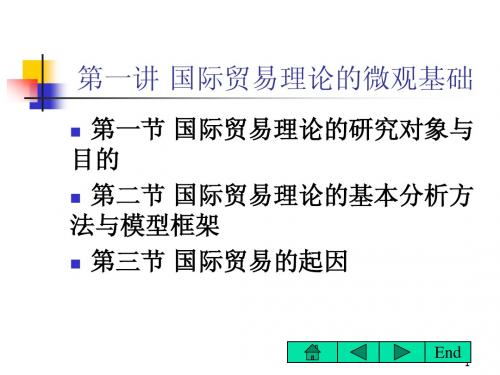
15
封闭条件下的一般均衡(2)
见教材P24页例子 页例子 见教材
国际贸易的发生是以两国相对价格存在差异为先决条 件的,即国际贸易是建立在相对价格差异基础上的。 由于A国在封闭条件下X商品的相对价格低于B国X商品 的相对价格,因此,我们称A国在X商品上具有比较优势 (Comparative advantage),在Y商品上处于比较劣势 (Comparative disadvantage);同样的道理,B国则在Y 商品上具有比较优势,在X商品上处于比较劣势。 从这个意义上讲,两国之间的贸易方向取决于比较优 势,即每个国家出口其具有比较优势的商品,进口其处 于比较劣势的商品。 End16
End 5
四、国际贸易理论的研究方法(1)
国际贸易理论采用实证分析( 国际贸易理论采用实证分析(Positive analysis) ) 和规范分析( 和规范分析(Normative analysis)两种。 )两种。 前者主要针对某一与国际贸易有关的现象,提 供理论分析框架,旨在解释诸如国际贸易发生的 原因、贸易形态的决定、贸易政策措施对国内经 济活动(如价格、生产;消费;收入分配)的影 响等问题; 后者则就某一与贸易有关的现象进行价值判断, 即说明其好坏,如就一国贸易政策的制定(是采 用自由贸易还是应采取贸易保护主义)提出依据。
End21
第三节 国际贸易的起因
一、一个没有贸易的假想的世界
这里仍然假设世界上只有两个国家,如果两个国家在封闭条件 下,相对价格完全一致,那么,即使允许商品在两国之间自由流动, 贸易也不会发生。 根据上面的讨论,我们引入以下5个条件: 1、 两国相同商品的生产函数相同 2、 两国的相对要素禀赋相同 3、 两国的消费偏好相同 4、 规模收益不变 5、 两国的商品市场和要素市场都是完全竞争的,并且不存在 外部经济性 上述5个条件保证了两国在封闭条件下的相对价格完全相同,因 此,在这些条件下国际贸易是不可能发生的。
国际经济学第二章

60
0
X
图 2-4(b)小囯的要素增长和贸易
三、 小囯的技术进步和贸易与财富
• 中性技术进步使得两种商品生产在相对价格不变 的条件下以相同比率增长。
• 只有在可出口商品生产中的中性技术进步是顺贸 易的。
• 不同类型的技术进步,会增加或降低贸易量,但 总是会增加小国的社会财富。
一、劳动增长与资本积累
• 图2-1表明了假设A国各类型要素增长的情况。对B国的说 明完全相似,由A可以推及B。图2-1中的左图说明假设A 国的劳动与资本两要素增加一倍的平衡增长情况。右图 重复了A国增长前的生产可能性曲线,并显示了另两条 分别为仅劳动或资本增加一倍时的生产可能性曲线。
Y
Q 2Y Q1Y
三、技术进步
• 当两种商品生产中的中性技术进步速度相同时,一国的 生产可能性曲线按照技术进步发生的速度向所有方向均 匀外移,这与生产要素平均增长时的效应相同。这种技 术进步的类型即图2-1左图所示。
Y QY2
QY1
A
A
A ’ B QX1
B
B’ QX2 X
0
图 2-3 中性技术进步
第二节
小国的经济增长与国际贸易
三、技术进步
• 过去的经验研究揭示了发达国家的实际人均收入 的增加主要是依靠技术进步,而资本积累的作用 则十分有限。然而,由于技术进步的类型不同, 而且不同的技术进步在每一种或同时在两种商品 生产过程中有着不同的比率,和要素增长分析相 比,技术进步的分析比较复杂。
三、技术进步
技术进步类型: (1)中性技术进步。中性技术进步是指劳动和资 本的生产效率(productivity)同比例增加。 (2)劳动节约型技术进步。劳动节约型技术进步 是指资本要素生产效率的增加大于劳动要素生产 效率的增加。 (3)资本节约型技术进步。资本节约型技术进步 是指劳动要素生产效率的增加大于资本要素生产 效率的增加。
国际经济学 第二章 国际贸易理论的微观基础
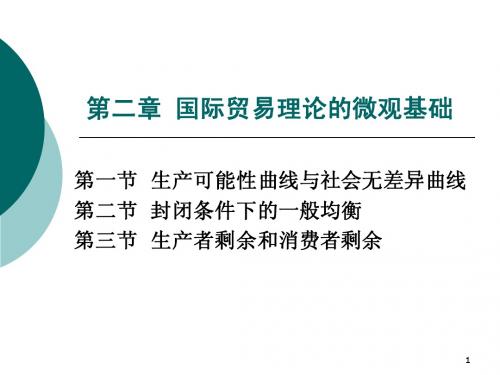
二、社会无差异曲线
1 、消费者无差异曲线
者带来相 同效用 能为消 费 者带来相同效用 满足的不 同商品组合 的连线
Y
UA=UB
A(10,40) ( , )
无差异曲线的性质: 无差异曲线的性质: •无数条无差异曲线 无数条无差异曲线 •离原点越远,效用水平越大 离原点越远, 离原点越远 •不相交 不相交
2
第一节
生产可能性曲线与社会无差异曲线
(一)生产可能性曲线的假设条件 假设: 假设: 两种商品( 和 ),两种要素( 和 ); ),两种要素 两种商品(X和Y),两种要素(K和L); 商品市场和生产要素市场都是完全竞争的; 商品市场和生产要素市场都是完全竞争的; 商品的生产技术条件都是既定的, 商品的生产技术条件都是既定的,并且规模收益 不变; 不变; 生产要素的总供给都是固定不变的; 生产要素的总供给都是固定不变的; 生产要素可在两个部门间自由流动; 生产要素可在两个部门间自由流动; 两种生产要素都充分利用; 两种生产要素都充分利用; 两个部门之间不存在外部性。 两个部门之间不存在外部性。
生产者剩余: 生产者剩余:生产者愿意接受的价格和实际接受的价格之间 的差额。 的差额。 消费者剩余: 消费者剩余:消费者愿意支付的价格和实际支付的价格之间 的差额。 的差额。
P b P0 a
S
Dቤተ መጻሕፍቲ ባይዱ
O
Q
15
习题
名词解释 1、生产可能性曲线 2、机会成本 3、社会无差异曲线 4、生产者剩余和消费者剩余 5、封闭条件下的一般均衡
Y Y1 Y2 △Y E1 E2
△X O X1 X2 X
最大产量组合不等于最佳产量组合,确定最佳产量, 最大产量组合不等于最佳产量组合,确定最佳产量,要引入无差异曲线
国际经济学第二部分国际贸易政策
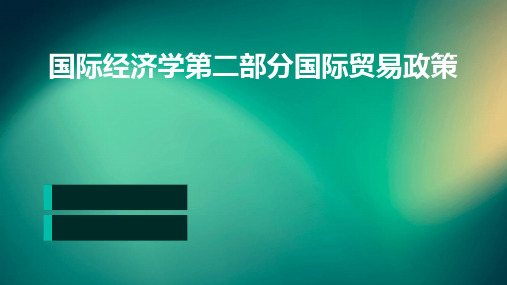
贸易政策与产业结构调整
贸易政策可以影响产业结构调整和升级。通过关税、配 额等手段,政府可以保护幼稚产业,促进产业升级和技 术创新。
最优贸易政策
最优贸易政策的理论探讨
最优贸易政策是指在一定条件下实现国家利益最大化的贸易政策。理论探讨包括比较优 势理论、竞争优势理论、战略性贸易政策等。
最优贸易政策的实践应用
02
贸易保护政策可能导致国内生产要素价格上升,增 加企业生产成本,从而降低国内生产规模。
03
自由贸易政策有助于降低企业生产成本,扩大市场 份额,促进企业规模经济和专业化分工。
贸易政策的产业结构效应
01 贸易政策通过影响比较优势和资源分配,进而影 响产业结构。
02 贸易保护政策可能保护夕阳产业,但同时也限制 了新兴产业的发展和比较优势的发挥。
各国在实践中根据自身国情和发展阶段制定最优贸易政策。发达国家通常采取自由贸易 政策,促进国际贸易和投资;发展中国家则可能采取适度保护的贸易政策,以促进经济
发展和产业升级。
05 贸易政策与实践
世界贸易组织的运行机制与规则
世界贸易组织的宗旨
推动自由贸易,促进全球经济繁荣和发展。
世界贸易组织的运行机制
详细描述
规模经济与国际贸易理论解释了为什么一些国家在出口某一产品时具有规模经济效应,从而在国际市场上获得竞 争优势。这种理论强调了生产规模和专业化生产对降低成本、提高产品质量和国际竞争力的影响。
产品生命周期与国际贸易
总结词
产品生命周期与国际贸易理论认为产品 在不同生命周期阶段需要不同的生产要 素和市场条件,这导致了国际贸易格局 的变化。
VS
详细描述
产品生命周期与国际贸易理论由美国经济 学家弗农提出,他认为产品从研发、生产 、成熟到衰退会经历不同的阶段,每个阶 段需要不同的生产要素和市场条件。因此 ,随着产品生命周期的变化,国际贸易的 格局也会发生变化。
International Economics国际经济学U2

2.3 Other New Classical Theories
T ρ ρ X0
T0 T1
X1
S0
S1
S
At constant world prices, if a country experiences an increase in the supply of one factor, it will produce more of the product whose production is intensive in that factor and less of the other product.
O
L L1 Total Labor Supply of the U.S.
O’
2.1 Specific Factor Model
The existence of specific factors can help explain why some groups resist free trade. In general, owners of the abundant factor of production in a country should be in favor of free trade. However, both capital and labor in the industry with a comparative disadvantage suffer losses and may well resist free trade.
2.1 Specific Factor Model
specific factor
Its
use is specific to either the production of machines or the production of cloth and cannot move between industries. Such as capital in the model.
国际经济学 第2版第2章 国际贸易理论的微观基础
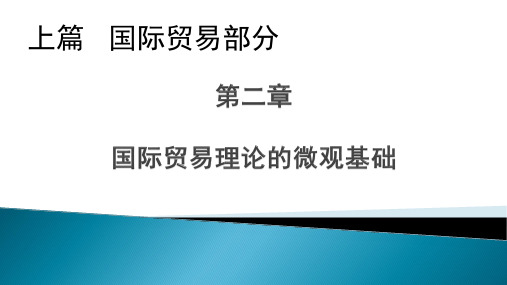
“相对价格”
假设PX和PY分别表示两种商品X和Y的货币价格,那么 PX/PY定义为商品X的相对价格。
涵义
用商品Y代替货币,作为商品X的计价单位,它表示用
一个单位的商品X与商品Y进行交换,所能得到商品Y的数
量。
数学表达:PX/PY
表示方法
Y
I PY
图形表达:
向右下方倾斜 的直线
PX X PYY I 斜率为PX/PY
E
NDX
XE
X
4.封闭条件下的相对价格差与贸易的发生
PX PY
NS X A
PX PY
1
2
NDX A
O
X
O
NS X B
NDX B
X
贸易的基础
相对价格的差异
由于A国在封闭条件条件下X商品的 相对价格低于B国X商品的相对价格
国民需求曲线的推导 Y
以商品X为例
该曲线斜率为负
消费量与相对价 格成反比关系
O
PX PY
2•
1• 1 2•
O
F • PX PY 2
E• •D
PX PY 1 2
D1 D2 D3
PX PY 1
X
•
•
• NDX
X
D1 D2 D3
国民供给曲线 国民需求曲线
PX PY
PX PY E
O
相交
NS X
均衡产量 消费水平 相对价格
商品市场的均衡
Y
YQ
Q (PX PY )'
X的相对价格上升, X的供给增加,
PX PY Y的供给下降。
YQ'
Q'
O
XQ
X Q'
International Economics chap 02(克鲁格曼国际经济学英文版)

Theory and Policy (Ninth Edition) Paul R. Krugman 黄卫平 彭刚
Chapter 2 Specific Factors and Income Distribution
CONTENTS
01
Understand how a mobile factor will Respond to price changes by mபைடு நூலகம்ving Across sectors?
1 2
LC2
3
AA
Labor Input in cloth, Lc
1 2
Production Possibility Frontier, PPF
BB(slope= -PC/ PF ,the minus relative 3 price of cloth)
QC2
Output of cloth, Qc
Production function for cloth
The same: MPLF×PF=w= MPLC×PC, or -MPLF/MLPC= -PC/ PF
Wage rate, w
10% PC increase
10% w increase
Labor used in cloth, LC
Price, wages and labor allocation-an equal-proportional change in prices
The main reasons that international trade has strong effects on the distribution of income are: 1. A short-run consequence of trade 2. A long-run consequence of trade
保罗克鲁格曼版国际经济学の国际贸易部分同步单项选择题第章
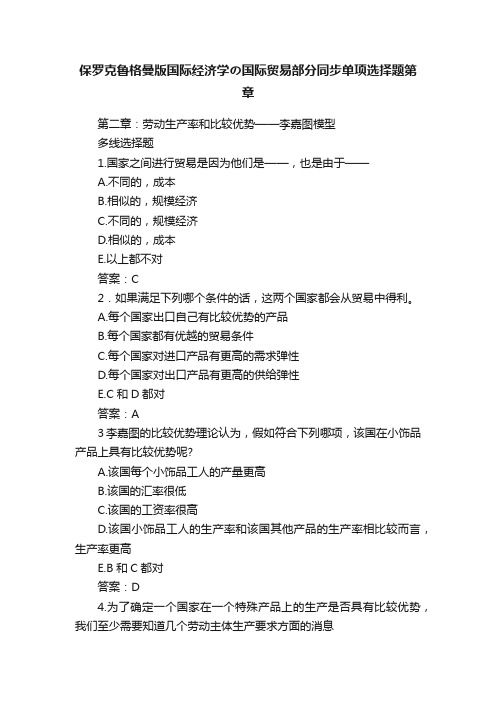
保罗克鲁格曼版国际经济学の国际贸易部分同步单项选择题第章第二章:劳动生产率和比较优势——李嘉图模型多线选择题1.国家之间进行贸易是因为他们是——,也是由于——A.不同的,成本B.相似的,规模经济C.不同的,规模经济D.相似的,成本E.以上都不对答案:C2.如果满足下列哪个条件的话,这两个国家都会从贸易中得利。
A.每个国家出口自己有比较优势的产品B.每个国家都有优越的贸易条件C.每个国家对进口产品有更高的需求弹性D.每个国家对出口产品有更高的供给弹性E.C和D都对答案:A3李嘉图的比较优势理论认为,假如符合下列哪项,该国在小饰品产品上具有比较优势呢?A.该国每个小饰品工人的产量更高B.该国的汇率很低C.该国的工资率很高D.该国小饰品工人的生产率和该国其他产品的生产率相比较而言,生产率更高E.B和C都对答案:D4.为了确定一个国家在一个特殊产品上的生产是否具有比较优势,我们至少需要知道几个劳动主体生产要求方面的消息A.一个B.两个C.三个D.四个E.五个答案:D5.根据比较优势原理,一个国家进行国际贸易从中得到收益,是以为A.间接生产出口产品比直接生产更有效B.间接生产进口产品比国内生产更有效C.可以用更少的劳动力生产出口产品D.使用更少的劳动力间接生产出口产品E.以上都不对答案:B6.根据下面的信息:单位劳动力需求布料小饰品国内1020国外6030A.没有一个国家有比较优势B.国内在布料生产方面具有比较优势C.国外在布料生产方面具有比较优势D.国内在饰品生产方面具有比较优势E.国内在这两件产品上都具有比较优势答案:B7.假如国外使用犯人生产出口产品,那么国内应该A.出口布料B.出口小饰品C.两种产品都出口,而不进口D.不从事任何进口和出口E.上面都对答案:A8.假如国内经济遭受了大萧条,每种产品的单位劳动需求翻了四倍。
那么国内应该A.出口布料B.出口小饰品C.出口布料,不进口D.不做任何出口或进口E.以上都正确答案:A9.假如国内工资水平翻倍了,那么国内应该A.出口布料B.出口小饰品C.出口布料,不进口D.不做任何出口和进口E.以上都正确答案:A10.根据下面的信息一个单位劳动力生产的数量布料小饰品国内1020国外6030A.没有一个国家有比较优势B.国内在布料生产上有比较优势C.国外在布料生产上有比较优势D.国外在饰品生产上有比较优势E.国内在两种产品上都有比较优势答案:C11.假如国外使用犯人生产出口产品,国外生产布料的机会成本是小饰品的生产,那么国内应该A.出口布料B.出口小饰品C.两种产品都出口,不进口D.不进口,也不出口E.以上都正确答案:B12.假如国内工资翻倍了,国内应该A.出口布料B.出口小饰品C.两种产品都出口,不进口D.不出口也不进口E.以上都对答案:B14.假设只有两个国家进行贸易,这两个国家只生产两种产品,那么国际贸易会使什么增加A.假如两种产品的产量都增加了,消费者福利才会增加B.两种产品的生产量和两个国家的消费者福利都会增加C.两种产品的生产量都增加了,但不是两个国家的消费者福利都增加D.两个国家的消费者福利增加了,但不是两种产品的总生产量都增加了E.以上都不正确答案:B15.根据李嘉图模型,贸易的结果会带来哪个趋于专业化A.16.根据李嘉图模型,参加贸易的国家会发现他的消费束A.在生产边界线内部B.在生产边界线上C.在生产边界线外部D.在他贸易国生产边界线内部E.在他贸易国生产边界线上答案:C17.在李嘉图模型中,假如一个国家的贸易受到限制,下列哪项不会发生?A.有限的专业化和劳动分工B.贸易额和贸易所得都减少C.使国家在生产边界线内部进行生产D.可能导致一个国家生产一些不具有比较优势的产品E.以上都不是答案:C18.根据李嘉图模型,假如一个很小的国家和一个非常大的国家进行贸易,那么A.小国家的经济福利会下降B.大国际的经济福利会下降C.小国家将从贸易中获利D.大国家将从贸易中获利E.以上都不正确答案:C19.假如一个国家的世界进出口交换率在H国和F国的国内生产成本比率之间,那么A.H国将从贸易中获利,而不是F国B.F国将从贸易中获利,而不是H国C.H国和F国都不能从贸易中获利D.只有进行出口补贴的国家能从贸易中获利E.以上都不对答案:B20.假如F国的进出口比率等于世界平均进出口比,那么A.H国将从贸易中获利,F国不能B.H国和F国都从贸易中获利C.H国和F国都不能从贸易中获利D.只有政府补贴出口的国家获利E.以上都不正确答案:A21.假如H国的进出口比率等于世界平均进出口比,那么A.H国将从贸易中获利,F国不能B.H国和F国都从贸易中获利C.H国和F国都不能从贸易中获利D.只有政府补贴出口的国家获利E.以上都不正确答案:E22.假如生产可能性曲线凹向原点,那么下列哪种情况会进行生产A.机会成本不变B.机会成本递增C.机会成本递减D.机会成本无限E.以上都不正确答案:B23.假如两个国家有相同的生产可能性曲线,那么在下列哪种情况下他们之间的贸易不可能发生A.他们的供给曲线相同B.他们的成本函数相同C.他们的需求函数不同D.他们的收入相同E.以上都不正确答案:C24.比较优势原理最早是谁提出的?A.大卫。
国际经济学(国际贸易部分)第二章 古典国际贸易理论

增口是任 加赚有何 本取限国 国别的家 财国,金 富金只银
银有储 才靠量 能出都
本国同 国购时 金买要 银别限
国制 商或 品禁 支止 出本
鼓励出口 限制或禁止进口
国际经济学(国际贸易部分)
三、重商主义的两个发展阶段
重商主义的发展可分两个阶段: 早期重商主义:15世纪-16世纪中叶 晚期重商主义:16世纪下半期-18世纪
绝对优势贸易理论 四个特点:
将劳动分工推广到国际领域,认为国际分工也会提高整个 社会的消费水平或福利水平
机会成本不变 简单直观 不能解释一国两产品劳动生产率均高于另一国两产品劳动
生产率均低的国家间的国际贸易
国际经济学(国际贸易部分)
绝对优势贸易理论的评价
进步性: 第一次从生产领域出发说明国际贸易发生与发展的必然性。 局限性: 只说明国际贸易中的特殊现象。即在一种商品的生产上处
国际经济学(国际贸易部分)
(一)早期重商主义—货币平衡论
代表人物:斯塔福(William Stafford) 政策主张:
强调绝对的贸易顺差,主张多卖少买或不买,要保持 每一笔交易和对每一个国家的贸易都实现顺差; 采取行政手段,控制商品进口,禁止货币输出以积累 货币财富。 早期重商主义者的这种思想被称为货币平衡论。
国际经济学
(国际贸易部分)
第2章 古典国际贸易理论
1.斯密之前的贸易思想 2.斯密的绝对优势贸易理论 3.李嘉图的比较优势贸易理论
国际经济学(国际贸易部分)
第一节 斯密之前的贸易思想
早期的分工交换思想 重商主义的贸易观点: 货币平衡论 贸易平衡论 重农学派的贸易观点
国际经济学(国际贸易部分)
国际经济学(国际贸易部分)
二、重商主义的贸易观点
国际经济学英文教材全文翻译(DOC)
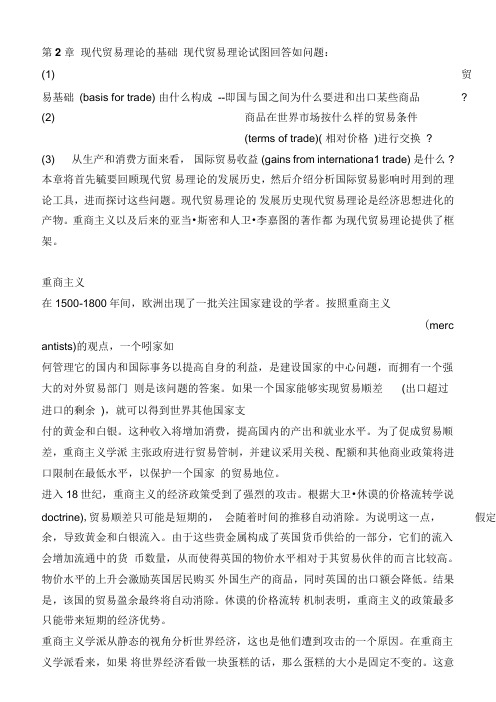
第2 章现代贸易理论的基础现代贸易理论试图回答如问题:(1) 贸易基础(basis for trade) 由什么构成--即国与国之间为什么要进和出口某些商品? (2) 商品在世界市场按什么样的贸易条件(terms of trade)( 相对价格)进行交换?(3) 从生产和消费方面来看,国际贸易收益(gains from internationa1 trade) 是什么?本章将首先毓要回顾现代贸易理论的发展历史,然后介绍分析国际贸易影响时用到的理论工具,进而探讨这些问题。
现代贸易理论的发展历史现代贸易理论是经济思想进化的产物。
重商主义以及后来的亚当•斯密和人卫•李嘉图的著作都为现代贸易理论提供了框架。
重商主义在1500-1800年间,欧洲出现了一批关注国家建设的学者。
按照重商主义(merc antists)的观点,一个吲家如何管理它的国内和国际事务以提高自身的利益,是建设国家的中心问题,而拥有一个强大的对外贸易部门则是该问题的答案。
如果一个国家能够实现贸易顺差(出口超过进口的剩余),就可以得到世界其他国家支付的黄金和白银。
这种收入将增加消费,提高国内的产出和就业水平。
为了促成贸易顺差,重商主义学派主张政府进行贸易管制,并建议采用关税、配额和其他商业政策将进口限制在最低水平,以保护一个国家的贸易地位。
进入18世纪,重商主义的经济政策受到了强烈的攻击。
根据大卫•休谟的价格流转学说doctrine),贸易顺差只可能是短期的,会随着时间的推移自动消除。
为说明这一点,假定余,导致黄金和白银流入。
由于这些贵金属构成了英国货币供给的一部分,它们的流入会增加流通中的货币数量,从而使得英国的物价水平相对于其贸易伙伴的而言比较高。
物价水平的上升会激励英国居民购买外国生产的商品,同时英国的出口额会降低。
结果是,该国的贸易盈余最终将自动消除。
休谟的价格流转机制表明,重商主义的政策最多只能带来短期的经济优势。
重商主义学派从静态的视角分析世界经济,这也是他们遭到攻击的一个原因。
国际经济学(双语)-教学大纲
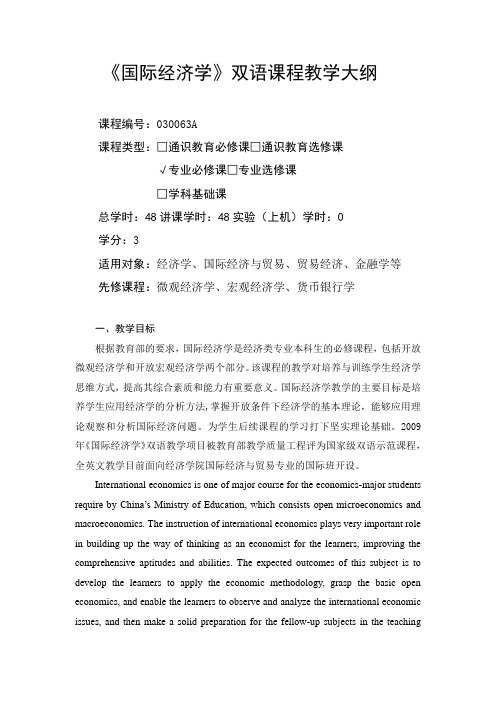
《国际经济学》双语课程教学大纲课程编号:030063A课程类型:□通识教育必修课□通识教育选修课√专业必修课□专业选修课□学科基础课总学时:48讲课学时:48实验(上机)学时:0学分:3适用对象:经济学、国际经济与贸易、贸易经济、金融学等先修课程:微观经济学、宏观经济学、货币银行学一、教学目标根据教育部的要求,国际经济学是经济类专业本科生的必修课程,包括开放微观经济学和开放宏观经济学两个部分。
该课程的教学对培养与训练学生经济学思维方式,提高其综合素质和能力有重要意义。
国际经济学教学的主要目标是培养学生应用经济学的分析方法,掌握开放条件下经济学的基本理论,能够应用理论观察和分析国际经济问题。
为学生后续课程的学习打下坚实理论基础。
2009年《国际经济学》双语教学项目被教育部教学质量工程评为国家级双语示范课程,全英文教学目前面向经济学院国际经济与贸易专业的国际班开设。
International economics is one of major course for the economics-major students require by China’s Ministry of Education, which consists open microeconomics and macroeconomics. The instruction of international economics plays very important role in building up the way of thinking as an economist for the learners, improving the comprehensive aptitudes and abilities. The expected outcomes of this subject is to develop the learners to apply the economic methodology, grasp the basic open economics, and enable the learners to observe and analyze the international economic issues, and then make a solid preparation for the fellow-up subjects in the teachingprogram. In 2009, this course was selected as the national bilingual teaching experimental course by China’s Ministry of Educ ation.二、教学内容及其与毕业要求的对应关系(一)教学内容本课程的主要内容是阐述国际经济学的基础知识。
第二章(2)国际经济学

贸易利益的来源——交换所得和分工所得 (1)交换所得是由于贸易的发生,出口和进口商 品的相对价格提高,导致福利水平增加的部分。 (2)分工所得是由于资源从比较劣势的部门转移 到比较优势的部门,资源得到更有效配置而使福 利水平增加的部分。
Y
E T
Ⅱ
A
Ⅲ Ⅰ
B
PW
O
PW
X
图2-9 交易所得与分工所得
所谓机会成本指的是多生产1单位某产品就 必须牺牲另一产品的产量。那么,各国具体应当 专业化生产何种商品,并不是由生产商品耗费的 劳动量或实际支出成本来决定,而应该考察物品 的机会成本。与他国相比,某种产品的机会成本 如果低的话,那么该产品就具有比较优势,反之 则处于比较劣势。
二、机会成本一定条件下的生产可能性曲线
二、贸易条件、相互需求及贸易福利
贸易条件(Terms of Trade)指的是一国 以出口交换进口的条件,即两国进行贸易时的 交换比率。在只有两个国家两种产品的模型中, 一国的出口产品的价格和进口产品价格的比率 就是该国的贸易条件。
贸易条件的变化取决于双方对进口商品的 需求弹性。如果一国对进口商品的需求增加, 但对方对自己的需求并没有增加,在其他条件 不变的情况下,国际贸易条件会对自己不利而 对对方有利,尤其当对方对自己的商品缺乏弹 性时,将会使本国出口商品的价格下降更为剧 烈,贸易条件就会更有利于进口需求弹性弱的 一方。
当机会成本一定时,生产可能性曲线是一 条直线。
生产可能性曲线的斜率也称为“边际转换 率”( Marginal rate of transformation, MRT),表示每多生产1单位的X(横轴商品) 而减少的Y (纵轴商品)数量,就是 X 的机会 成本。
表2-1
国际经济学章节知识点总结
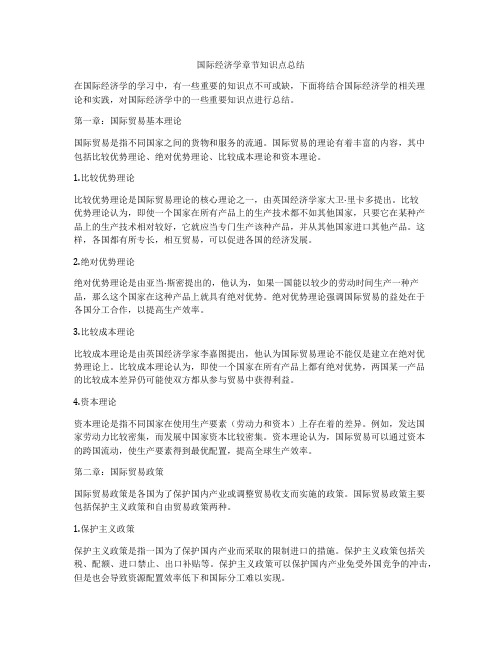
国际经济学章节知识点总结在国际经济学的学习中,有一些重要的知识点不可或缺,下面将结合国际经济学的相关理论和实践,对国际经济学中的一些重要知识点进行总结。
第一章:国际贸易基本理论国际贸易是指不同国家之间的货物和服务的流通。
国际贸易的理论有着丰富的内容,其中包括比较优势理论、绝对优势理论、比较成本理论和资本理论。
1.比较优势理论比较优势理论是国际贸易理论的核心理论之一,由英国经济学家大卫·里卡多提出。
比较优势理论认为,即使一个国家在所有产品上的生产技术都不如其他国家,只要它在某种产品上的生产技术相对较好,它就应当专门生产该种产品,并从其他国家进口其他产品。
这样,各国都有所专长,相互贸易,可以促进各国的经济发展。
2.绝对优势理论绝对优势理论是由亚当·斯密提出的,他认为,如果一国能以较少的劳动时间生产一种产品,那么这个国家在这种产品上就具有绝对优势。
绝对优势理论强调国际贸易的益处在于各国分工合作,以提高生产效率。
3.比较成本理论比较成本理论是由英国经济学家李嘉图提出,他认为国际贸易理论不能仅是建立在绝对优势理论上。
比较成本理论认为,即使一个国家在所有产品上都有绝对优势,两国某一产品的比较成本差异仍可能使双方都从参与贸易中获得利益。
4.资本理论资本理论是指不同国家在使用生产要素(劳动力和资本)上存在着的差异。
例如,发达国家劳动力比较密集,而发展中国家资本比较密集。
资本理论认为,国际贸易可以通过资本的跨国流动,使生产要素得到最优配置,提高全球生产效率。
第二章:国际贸易政策国际贸易政策是各国为了保护国内产业或调整贸易收支而实施的政策。
国际贸易政策主要包括保护主义政策和自由贸易政策两种。
1.保护主义政策保护主义政策是指一国为了保护国内产业而采取的限制进口的措施。
保护主义政策包括关税、配额、进口禁止、出口补贴等。
保护主义政策可以保护国内产业免受外国竞争的冲击,但是也会导致资源配置效率低下和国际分工难以实现。
国际经济学(上)-国际贸易部分第八版—第二章讲解

正在演变的世界贸易模式
1. 世界变小了吗? 2. 人们交换什么产品? 3. 服务外包 4. 旧规则依然可行吗?
世界变小了吗?
第二次经济全球化浪潮(1914年开始) 1. 两次世界大战 2. 30年代资本主义世界经济大萧条 3. 全世界范围内的贸易保护主义。 第二次经济全球化浪潮使世界再次变大
人们交换什么产品?
2008年世界出口产品按百分比划分的示意图。工业制成品占据世界贸易中最 大的份额,2008年出口的矿产品中包含了石油和其他燃料。农产品贸易虽然对很 多国家的人们生活至关重要,但是在整个当代贸易总额中所占比例很小。服务出 口包括传统的运费、保费和旅游收人。近些年来,现代通信业催生了多种新的服 务贸易,海外呼叫中心等服务贸易。
贸易引力模型的内容
不变:两国间贸易额的决定因素 都取决于三个因素,即两国各 自的GDP以及距离
不同:放松了两国贸易与国内生产 总值成正比,与两国距离成反比 的假设。取而代之,是选择合适 的a, b,c以拟合实际的经济数据。
贸易引力模型蕴含的内在逻辑
广义的逻辑:大的经济体由于收入高, 因而大量进口产品。同时,由于大的经济体 可以生产更多品种的系列产品,因而更能满 足其他国家的需求,进而大量出口产品。在 两国贸易中,任一方的经济规模越大,则双 方的贸易量就越大。
国界对贸易产生负效应
贸易引力模型蕴含的内在逻辑
✓ 在不考虑国家之间的距离时,贸易引力模型为: TIJ = A* YI *YJ
《国际经济学》第二章PPT教学课件
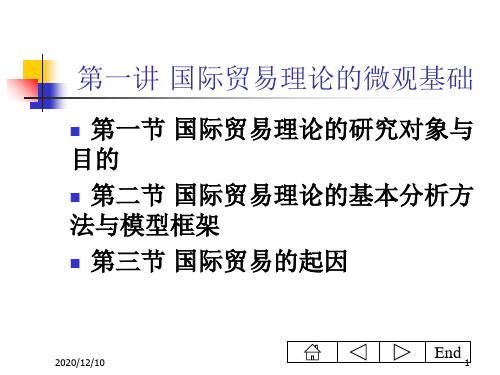
该国的福利水平;但必须指出,社会无差异曲线由低
处向高处移动,虽然表明国家的整体福利水平提高了,
但并意味着所有社会成员的福利水平都同时获得提高。
同样,消费点在同一条社会无差异曲线上移动,表示
整个国家的福利水平不变,但也并不意味着所有社会 成员的福利都不变。
前者主要针对某一与国际贸易有关的现象,提 供理论分析框架,旨在解释诸如国际贸易发生的 原因、贸易形态的决定、贸易政策措施对国内经 济活动(如价格、生产;消费;收入分配)的影 响等问题;
后者则就某一与贸易有关的现象进行价值判断, 即说明其好坏,如就一国贸易政策的制定(是采 用自由贸易还是应采取贸易保护主义)提出依据。
2020/12/10
End 8
一、国际贸易学图形分析的基本知识
局部均衡中的贸易获利:
所谓局部均衡是指分析研究一种商品在单独的一个市 场中的供应和需求的价格。
消费者剩余是指消费者在购买商品时,其实际支付的 价格和愿意支付的价格之间的差额。消费者剩余的面积, 是需求线以下,价格线以上的部分。
生产者剩余的面积,是供应线以上,价格线以下的部 分。一般而言,价格下降使消费者剩余增加,当价格上 升时,生产者剩余增加。
2020/12/10
End 12
主要分析工具(2)
(二)消费者偏好与社会无差异曲线
在国际贸易理论中,社会无差异曲线主要有两种用 途:(1)社会无差异曲线可以用来确定一国的均衡 消费点。(教材P21)(2)从规范分析的角度看,社 会无差异曲线可以用来衡量整个社会的福利。如若贸
易地方开展导致社会无差异曲线向远离坐标原点的方
2020/12/10
End 10
国际贸易研究方法的特点(2)
- 1、下载文档前请自行甄别文档内容的完整性,平台不提供额外的编辑、内容补充、找答案等附加服务。
- 2、"仅部分预览"的文档,不可在线预览部分如存在完整性等问题,可反馈申请退款(可完整预览的文档不适用该条件!)。
- 3、如文档侵犯您的权益,请联系客服反馈,我们会尽快为您处理(人工客服工作时间:9:00-18:30)。
Carbaugh, Chap. 2
12
Comparative advantage
Supply schedules: constant opportunity costs
Carbaugh, Chap. 2
13
Comparative advantage
Trading under constant opportunity costs
Generalizes theory to include all factors, not just labor Shows combinations of products that can be made if all factors are used efficiently Slope, or marginal rate of transformation, shows the opportunity cost of making more of one good (how much of one good must be given up to make more of another)
Carbaugh, Chap. 2
5
Content
Historical development of modern trade theory Production possibilities schedules Trading under constant cost conditions Productivity and comparative advantage Trade restrictions Trade under increasing-cost conditions Comparative advantage extended to many products and countries
Comparative advantage: the US has an absolute advantage in both goods Output per labor hour Nation Wine Cloth United States United Kingdom
Carbaugh, Chap. 2
Carbaugh, Chap. 2
10
Comparative advantage
Marginal Rate of Transformation
Carbaugh, Chap. 2
11
Comparative abilities schedules: constant opportunity costs
After Specialization
Autos Wheat 120 0 120 0 160 160
Net Gain (Loss)
Autos Wheat 80 -40 40 -40 80 40
Carbaugh, Chap. 2
15
Comparative advantage
Consumption gains from trade: constant
Autos Wheat 7 -4 3 -4 7 3
Carbaugh, Chap. 2
24
Increasing opportunity costs
Consumption gains from trade:
increasing opportunity costs
Before Trade
Autos Wheat US Canada World 5 17 22 18 6 24 5 20 25
Carbaugh, Chap. 2
22
Increasing opportunity costs
Trading under increasing costs: Canada
Carbaugh, Chap. 2
23
Increasing opportunity costs
Production gains from specialization:
Key concepts and terms
Autarky Basis for trade Complete specialization Constant opportunity costs Consumption gains Exit barriers Free trade Gains from international trade
Carbaugh, Chap. 2
18
Comparative advantage
Trade restrictions and gains from trade
Carbaugh, Chap. 2
19
Increasing opportunity costs
Production possibilities schedule under increasing costs
40 bottles 40 yards 20 bottles 10 yards
8
Comparative advantage
Ricardo’s Comparative Advantage in money prices
Nation Labor Wage Cloth (yards) Quant. Price Wine (bottles) Quant. Price
Carbaugh, Chap. 2
6
Foundations of trade theory
Historical development of trade theory
Mercantilism
Regulation of trade to ensure a positive trade balance Critics: possible only for short term; assumes static world economy Absolute advantage (Adam Smith) Countries benefit from exporting what they make cheaper than anyone else But: nations without absolute advantage do not gain from trade
Carbaugh, Chap. 2
16
Comparative advantage
Complete specialization under constant opportunity costs
Carbaugh, Chap. 2
17
Comparative advantage
Changing comparative advantage
Comparative advantage (David Ricardo)
Nations can gain from specialization, even if they lack an absolute advantage
Carbaugh, Chap. 2
7
Comparative advantage
Carbaugh, Chap. 2
2
Increasing opportunity costs Labor theory of value Marginal rate of transformation Mercantilists Partial specialization Price-specie-flow doctrine Principle of absolute advantage Principle of comparative advantage
Carbaugh, Chap. 2
14
Comparative advantage
Production gains from specialization:
constant opportunity costs
Before Specialization
Autos Wheat US Canada World 40 40 80 40 80 120
Absolute & Comparative Advantage
Absolute advantage: each nation is more efficient in producing one good Output per labor hour Nation Wine Cloth
United States United Kingdom 5 bottles 20 yards 15 bottles 10 yards
opportunity costs
Before Trade
Autos Wheat US Canada World 40 40 80 40 80 120 60 60 120
After Trade
Autos Wheat 60 100 160
Net Gain (Loss)
Autos Wheat 20 20 40 20 20 40
4
Modern trade theory seeks to answer the following questions:
What constitutes the basis for trade? At what terms of trade are products exchanged in the world market? What are the gains from international trade in terms of production and comsuption?
increasing opportunity costs
Before Specialization
